By Laura Burgazzi, Foyle Special Collections Library, King’s College London
Gregor Reisch (c1470–1525) wrote Margarita philosophica (Philosophical pearl) between 1489 and 1496. Reisch was a monk who achieved BA and MA degrees from the University of Freiburg in 1488 and 1489/1490, before subsequently entering the Carthusian Order. The editio princeps (first edition) of the Margarita was printed in Freiburg in July 1503 by Johannes Schott (1477–1548), a Strasbourg-based printer who had attended the universities of Basel, Freiburg and Heidelberg. During the 16th century, the Margarita was reprinted at least 12 more times by various printers in Strasbourg, Basel and Venice. This suggests a sustained interest in this work.
Reisch modelled the Margarita on the arts curriculum that he studied at Freiburg. However, arts curricula were very similar across Europe, and so it was also useful to arts scholars at other universities. As a result, it was used in lectures at some universities, such as Heidelberg and Louvain. It was also mentioned in contemporary documents from other university towns, including Oxford and Cambridge. Reisch adapted the curriculum’s content to adhere to the classic academic format of a discussion between a master and a student, which would have made the content more engaging and readable.
The first seven books in the Margarita cover each of the seven liberal arts. The work begins with the elementary trivium (grammar, logic and rhetoric), followed by the more advanced quadrivium (arithmetic, music, geometry and astronomy). The last five books discuss natural and moral philosophy.
The edition held in the Foyle Special Collections Library
The Foyle Special Collections Library holds one copy of the Margarita within its Rare Books Collection. This copy is extremely interesting, as a result of its numerous marks of ownership, illustrations and annotations. It is also a first edition.
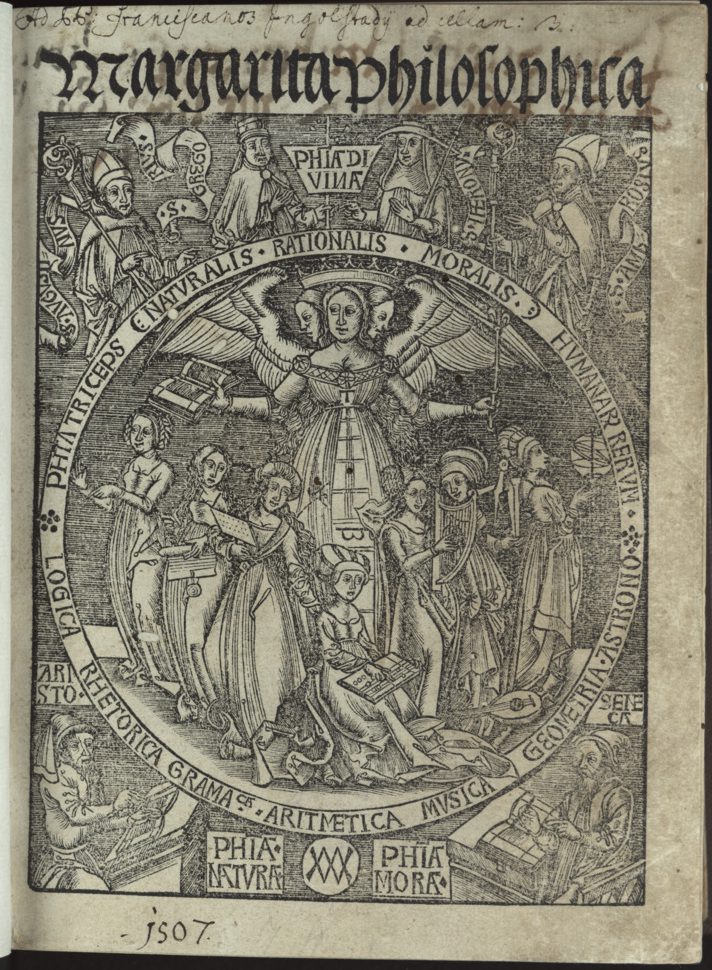
Its title page clearly illustrates the Margarita’s content. The figure at the centre of this woodcut represents the personification of Philosophy, whose three heads look to the past, the present and the future. Personifications of the seven liberal arts are present at Philosophy’s feet, with each holding an item identifying them, for instance Astronomia (the personification of astronomy) holds an astrolabe. At the top of the illustration four saints represent ‘divine philosophy’: St Augustine, St Gregory, St Jerome and St Ambrose. Below the circle are Aristotle and Seneca, representing ‘natural’ and ‘moral’ philosophy, respectively.
Provenance
Three hand-written ink inscriptions at the beginning of our copy suggest that it was gifted to the Franciscan monastery in Ingolstadt, Germany, in 1507 by the Franciscans of nearby Amberg. The Franciscan Order typically had a ‘pronounced intellectualist bent’, according to historian WR Jones, and so it is understandable that Franciscan friars would be interested in holding an intellectual work such as the Margarita. In addition, the Ingolstadt monastery had its own workshop from at least 1475, suggesting a developed interest in books and book production.
 This copy contains two bookplates on its front paste-down. One belongs to Sir Thomas Brooke (1830–1908), the director of a manufacturing firm and a major collector of books and manuscripts who became a Fellow of the Society of Antiquities in 1871. The Margarita featured in the catalogue of Brooke’s books published in 1891, though he wrongly classified it as a 1507 edition because this date is included in two of the three ink inscriptions. Brooke declared in the catalogue’s preface that most of his books were purchased after 1854, and so the Margarita is likely to have come into his possession sometime between 1854 and 1891.
This copy contains two bookplates on its front paste-down. One belongs to Sir Thomas Brooke (1830–1908), the director of a manufacturing firm and a major collector of books and manuscripts who became a Fellow of the Society of Antiquities in 1871. The Margarita featured in the catalogue of Brooke’s books published in 1891, though he wrongly classified it as a 1507 edition because this date is included in two of the three ink inscriptions. Brooke declared in the catalogue’s preface that most of his books were purchased after 1854, and so the Margarita is likely to have come into his possession sometime between 1854 and 1891.
The other bookplate belongs to John William Adamson (1857–1947), an eminent professor of the history of education. In 1881, Adamson graduated from an arts degree at King’s, and he returned to work at their Department for the Training of Teachers in 1890. He held successive positions in this department and was Professor of Education at King’s from 1903 to 1924. As a result of this close connection, the Margarita was among the books bequeathed to King’s by Adamson.
Illustrations
This edition of the Margarita contains 19 full-page woodcuts and numerous smaller woodcuts throughout the text. These woodcuts were designed by Alban Graf, who had attended the University of Basel. As a result of his university education, Graf could read and understand the text while preparing his illustrations, which ensured their relevance to the text.
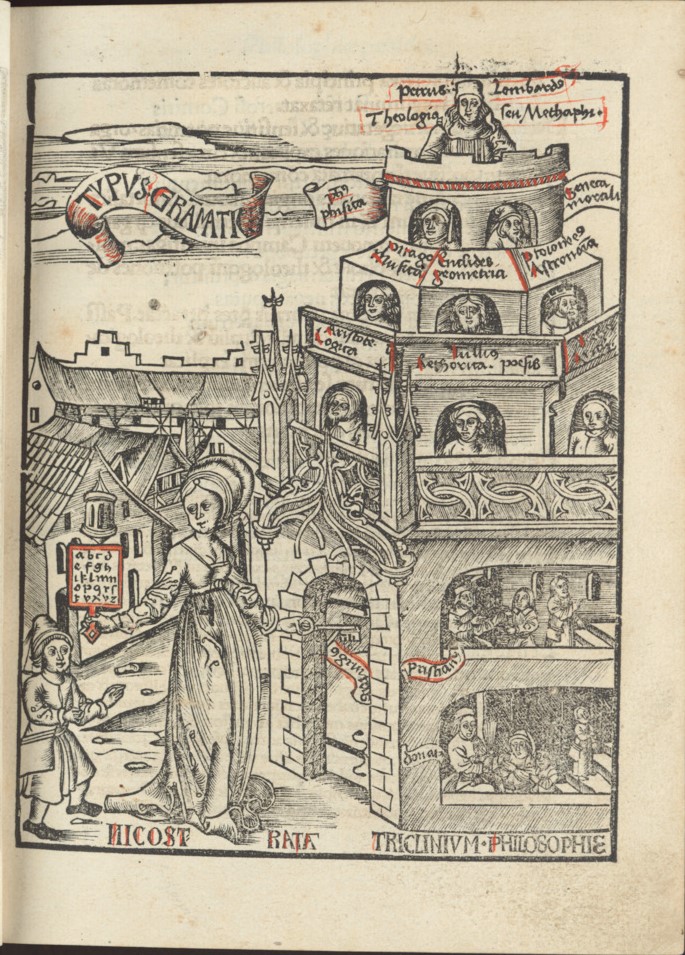 Many of the full-page woodcuts introduce new sections of the work, such as this woodcut that introduces Book one (Grammar). This illustration features Nicostrata leading a child towards the Tower of Learning, for which she holds the key. Nicostrata was an ancient goddess and a patron of prophecy, scientific innovation and scholarship. Nicostrata is holding a reader with the Latin alphabet, as she is typically said to have altered the letters of the Greek alphabet to form the Latin alphabet. Each level of the tower features figures representing the seven liberal arts and philosophy. Peter Lombard (c1100–60) and Metaphysics occupy the highest position at the top of the tower, reflecting the perceived superior position of this subject.
Many of the full-page woodcuts introduce new sections of the work, such as this woodcut that introduces Book one (Grammar). This illustration features Nicostrata leading a child towards the Tower of Learning, for which she holds the key. Nicostrata was an ancient goddess and a patron of prophecy, scientific innovation and scholarship. Nicostrata is holding a reader with the Latin alphabet, as she is typically said to have altered the letters of the Greek alphabet to form the Latin alphabet. Each level of the tower features figures representing the seven liberal arts and philosophy. Peter Lombard (c1100–60) and Metaphysics occupy the highest position at the top of the tower, reflecting the perceived superior position of this subject.
While this illustration is almost identical in all extant copies of the Margarita, some of the woodcuts vary greatly between different editions. This is the case for the woodcut outlining the Ptolemaic model of the cosmos, which features in the first tract of Book seven (Astronomy) and, in our edition, is repeated in tract one of Book nine (Natural things). In this edition, this full-page woodcut features Astronomia above the cosmological model and Atlas (the Titan condemned to hold the heavens for eternity) at the centre of the diagram.
This woodcut is markedly different in other editions. In the 1504 edition printed by Johann Grüninger in Strasbourg, the diagram was reduced to only occupy part of the page and Astronomia is missing. The man has also been removed to reveal the Earth at the centre of the cosmos, surrounded by spheres of water, air, and fire.
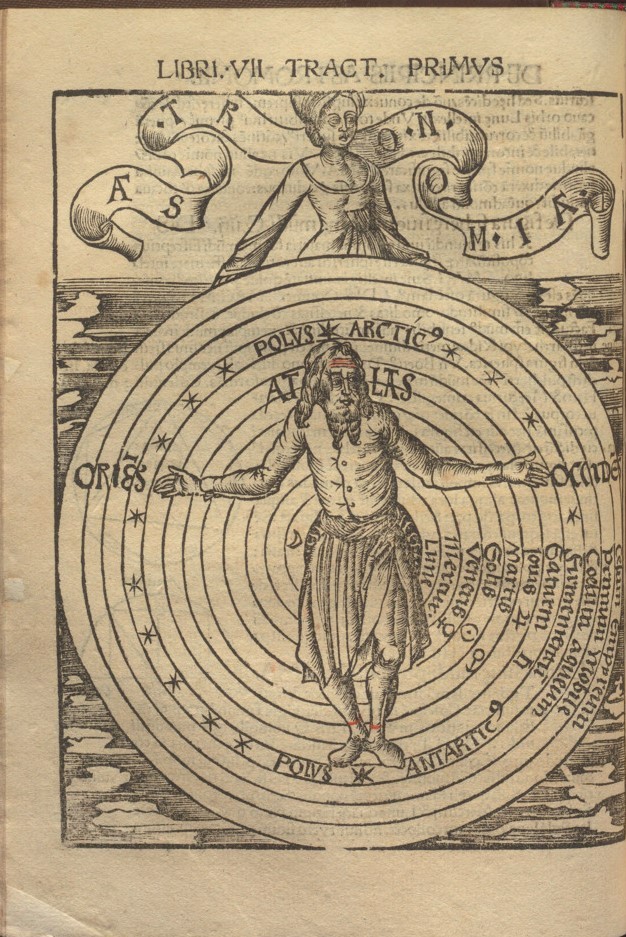

While almost all of the full-page woodcuts have been rubricated in our copy of the Margarita, only one has been hand coloured. It is also the only woodcut to have been mutilated, presumably by a later owner. This woodcut from Book seven (Astronomy) depicts a zodiac man. Zodiac men were based on the ancient astrological idea that everything on Earth, including human beings, was influenced by the stars and planets. Each of the 12 zodiac signs was said to rule a part of the body: Aries ruled the head, Taurus ruled the neck, etc., with the signs continuing in order down the body until Pisces, which ruled the feet.
Although Alban Graf took great care when designing the woodcuts for this text, Cancer and Leo appear in the wrong order. However, he was only responsible for designing the illustration, and so this mistake could have been made by the individual who traced the illustration onto the woodblock before it was cut. Nonetheless, this error remained in later editions published by Johannes Schott in 1504 and 1508, the 1517 edition produced by Schott’s publishing partner, Michael Fürter, in Basel, and the 1583 edition published by Sebastian Henricpetri in Basel.
This illustration was also changed in Johann Grüninger’s editions of the Margarita. He used an alternative and much smaller woodcut for his zodiac man in the first two editions (1504 and 1508), while in the latter two (1512 and 1515) he omitted the zodiac man entirely. The zodiac man was completely redesigned again for the editions published by Barezzo Barezzi and Jacomo Antonio Somascho in Venice in 1599.


Annotations
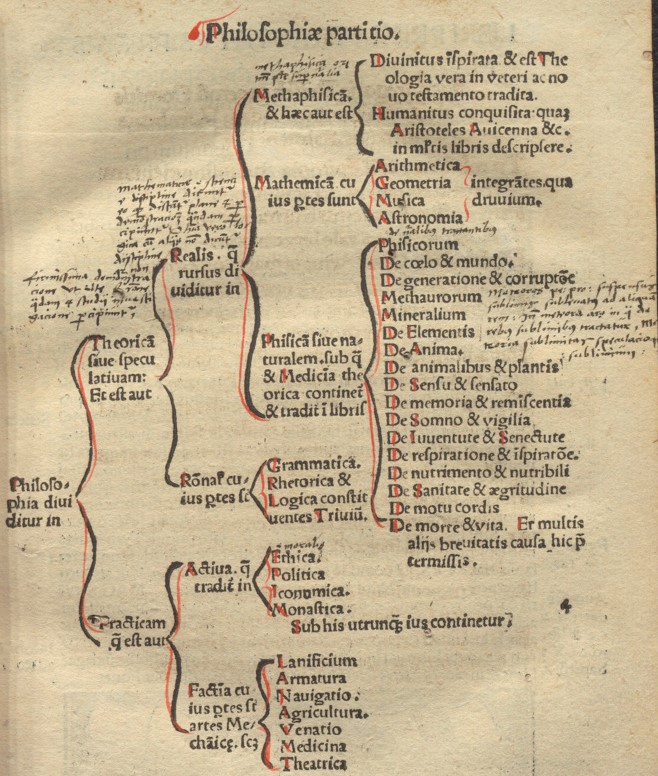 Our copy has annotations throughout. Each page of the work features a degree of rubrication, from the highlighting of select letters in red ink to the addition of decorated initials and marginal diagrams. Annotations in black ink also appear in various hands throughout the text. One hand commented on the contents pages and the division of philosophy diagram that appears in the front matter, another underlined and signposted the section on oration in Book three (Rhetoric), and a third made corrections to parts of the text, for example, in Book four (Arithmetic). These annotations suggest that multiple readers have made practical use of this book throughout its history.
Our copy has annotations throughout. Each page of the work features a degree of rubrication, from the highlighting of select letters in red ink to the addition of decorated initials and marginal diagrams. Annotations in black ink also appear in various hands throughout the text. One hand commented on the contents pages and the division of philosophy diagram that appears in the front matter, another underlined and signposted the section on oration in Book three (Rhetoric), and a third made corrections to parts of the text, for example, in Book four (Arithmetic). These annotations suggest that multiple readers have made practical use of this book throughout its history.
Overall, the Margarita is an exemplary text for studying the history of education. It clearly illustrates the topics studied by late medieval arts scholars, and the fact that it was continually reprinted in the 16th century emphasises its popularity with this audience. Although the Margarita contained a number of carefully designed woodcuts, which were often redesigned in later editions, it was not merely a coffee table book. The numerous annotations throughout our edition clearly highlight this.
Bibliography
Brian Barber, ‘Working in “The Cause of Bibliomania Throughout the World”: Sir Thomas Brooke (1830–1908), a Yorkshire Businessman-Bibliophile’, The Yorkshire archaeological journal, 90:1 (2018), pp 158–177.
Thomas Brooke, Catalogue of the manuscripts and printed books collected by Thomas Brooke, F.S.A., and preserved at Armitage Bridge House, near Huddersfield, 1891: vol. II, M-Z (London: Ellis and Elvey, 1891).
Andrew Cunningham and Sachiko Kusukawa, Natural philosophy epitomised: a translation of books 8-11 of Gregor Reisch’s Philosophical pearl (1503) (Farnham: Ashgate, 2010).
WR Jones, ‘Franciscan Education and Monastic Libraries: Some Documents’, Traditio, 30 (1974), pp 435-445.
Ulrike Marburger, ‘The German Database of Historical Bookbindings (EBDB): Aims and Perspectives of a Cooperative Research Tool’ in Bettina Wagner and Marcia Reed (eds), Early printed books as material objects: proceedings of the conference organized by the IFLA Rare Books and Manuscripts Section, Munich, 19-21 August 2009 (Berlin: De Gruyter, 2010), pp 199-203.
The images provided are all taken from the copy held in the Foyle Special Collections Library unless otherwise stated. Those reproduced from other institutions are provided in accordance with their stated permissions.
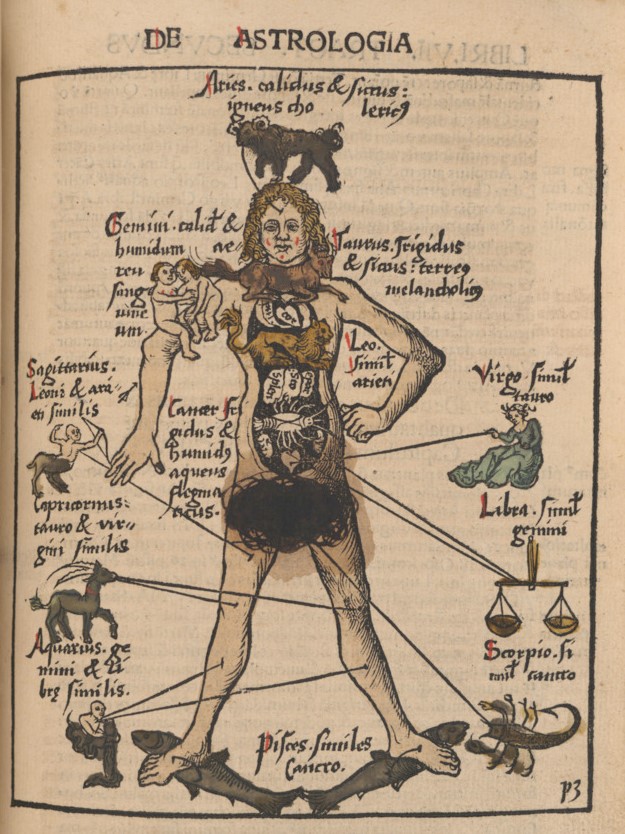
This is truly remarkable!!